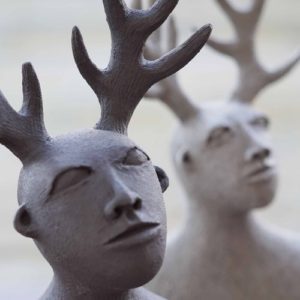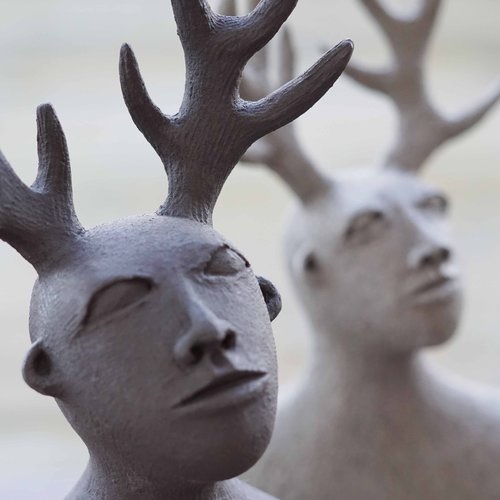
June says of her work “I am nearly three years old. My father is carrying me on his shoulders down to the river to feed the swans. I walk part of the way and fill my pockets with banded snails, Cepaea Hortensis. Feathers. Small treasures.
My father was for a time a shepherd. We learn the names of the trees, of the flowers and birds. My mother collected the broken glass from church windows, my grandfather a glassblower in the Netherlands.
I am half Dutch. Stories of war and of loss. I am half English, trout swimming, birds singing, summer green and endless, leaves falling in autumn.
In my pocket, a golden leaf, the brilliant iridescent blue banded feather of a jay.
These are the stories that make up my life.
In my hands a memory. On the table an accumulation of small treasures. Poetry stones of clay, creatures of the forest, antlers, a wren. Windows of brilliant cast glass – colour, diamonds of light. By my side my granddaughter and now also a grandson, small and not yet unfurled, small stones, a leaf, a feather.”
For more information visit June’s website www.junekingsbury.com
Following her BA and MA at High Wycombe, June spent around 15 years making blown glass sculptures, often using found dead animals and encasing them in glass or slip. Her interest in Nature started at an early age, always foraging for snails or beetles, she has continued to draw inspiration and joy from her natural surroundings. Until recently her clay pieces were more about form and the aging process of minimal slip glazes; preferring to let lichens grow where glaze could be June experimented with form and let time and weather see to the finish. She works in different types of clay from T material to cranks, black and grey. She buys an inexpensive grey crank from Tiranti in Thatcham (tiranti.co.uk) which fires to a light buff, and proves to be quite flexible in firing to mainly earthenware temperatures. All her glazes are earthenware, the large sculptures are fired to Stoneware and are largely built with T material because it is lovely to use and looks like stone, these are coloured where required with oxides, and some large forms are Raku fired.
For our demonstration June made the start on a figure; using as a base a slabbed shape formed in a bisque mould bowl for the shoulders, she would then normally coil onto this ‘body’ to make it taller. From this she cuts a hole out in the middle and pulls up the edges to start forming a neck, again she scores and slips coils on to gradually build up the neck, out for the chin and back of the head – you must allow time for these coils to dry slightly so they can support the weight of the whole head, too fast and the sculpture will slump. The antlers are made separately, simply by hand then refined when leatherhard using a serrated tool to achieve the required texture. Features grow, and are all different, eyes used to be closed but now they can be open.
Following this June showed us how she makes her leaf tiles and pebbles. Clay is rolled into a slab, using guide sticks and turning the clay as it is rolled out to help prevent warping. June suggests using leaves that have a strong vein structure – not ivy – their veins will show up more when oxides or underglazes are added, you can use dry leaves, just add a damp brush of water to them so they stick to the clay. The leaf is placed onto the slab and then an underglaze is applied over the top with a brush (OPUS underglazes are used from Bisque-Direct www.bisquedirect.com). Then, slowly peel the leaf off starting at the stem, then cut out the tile shape you require, dry very slowly between boards is best before bisque firing. Following the bisque firing oxides or black underglaze can be applied to bring out the veins in the leaves, paint it on then gently wipe it off leaving it in the grooves of the veins before the final glost firing. If you want your leaf to appear in bas-relief, lay the leaf on the slab and wipe over and over it until the clay around it washes away slightly. The pebble stones have the same process with smaller leaves and are fired without hollowing so are quite small, larger stones would need to be hollowed. Instead of a tile you could make a bowl using the same technique, use a bisque fired mould and lay your rolled slab in it, use a rubber kidney to press and smooth the slab down into the mould from the middle out to the edges then cut around the edges with a harp tool to remove any excess, smooth the edges and dry on a board, not in the mould otherwise it will dry too quickly and crack. The nest bowls are made from a buff clay with a dark slip painted over then sgrafitto marks made through the slip revealing the paler colour under, 4 little glazed eggs sit in the nest, carved out and carefully glazed within the carved lines.
